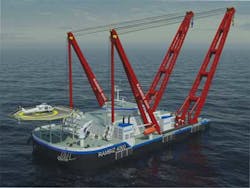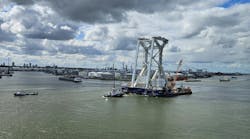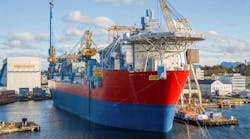Douglas-Westwood's "World Floating Production Market Forecast 2015-2019" predicts that despite the current low oil price environment, between 2015 and 2019 $81 billion will be spent on FPS units – an increase of 73% compared to 2010-2014. The value of annual installations is projected to grow from nearly $12 billion in 2015 to $21 billion in 2017 before declining to $17 billion in 2019. Projects already ordered will account for much of this spend.
Despite capex growth, the outlook this year for orders is poor, Douglas-Westwood stated. The low oil price is expected to impact the market, leading to a number of delayed project sanctions. This can be seen in the declining number of orders for 2015 and subsequent installation decline in 2018. Projects already under construction are unlikely to be affected.
FPSOs represent by far the largest segment of the market both in numbers (87 installations) and forecast capex (81%) during 2015-2019. TLPs account for the second largest segment of capex (9%) with FPSSs third (7%).
Latin America will see nearly one-third of the 110 installations forecast and 32% of the projected capex.
Scaldis orders newbuild DP-2 crane vessel
Scaldis Salvage & Marine Contractors NV ordered a self-propelled DP-2 crane ship from Royal IHC. Delivery is scheduled for spring 2017 in Europe. The vessel will be built under full responsibility and coordination of Royal IHC in Qidong and finished in Xiamen, both in the People's Republic of China.
The design was drawn up in-house in cooperation with Vuyk Engineering Rotterdam.
The ship is designed to have two Huisman cranes each with a lifting capacity of 2,000 tons. The ship also has extra carrying capacity of 3,000 tons. The cranes can be moved by 25 m (82 ft) on the ship. This allows the deck to be used to transport and then relocate cargo at a later stage, said Scaldis.
The maximum load will be able to be hoisted in significant wave heights of up to 1.5 m (5 ft). In standby or transport modes, significant wave height can be as much as 7.0 m (23 ft). The maximum load can be lifted in water depths of around 5 m (16 ft).
Coastal Offshore sells two offshore support vessels
Coastal Offshore (Labuan) Pte Ltd. has secured contracts for the sale of two offshore support vessels for an aggregate value of approximately RM197 million ($54 million). Both of these vessels were sold to customers in Mexico and are expected to be delivered in 2015 and 2017.
Goliat platform readies for Norway
The Goliat platform has been towed on board the Dockwise Vanguard and is ready for departure to the Eni-operated Goliat field in the Norwegian sector of the Barents Sea. At 107 m (351 ft) in diameter, the Goliat platform is the largest cylindrical FPSO facility ever built. It was designed by Sevan Marine in Arendal especially for the Arctic conditions of the Barents Sea, and was built at Hyundai Heavy Industries' yard in South Korea. The Goliat field FPSO has a production capacity of about 100,000 b/d and a 1 MMbbl storage capacity.
The Eni-operated Goliat field is the world's northernmost offshore oil field, and will be the first oil field to come into production in the Norwegian sector of the Barents Sea. The field is expected to come onstream in 1H 2015.
The platform will be supplied with electrical power from the mainland using the longest submarine cable of its type in the world.
Displaying 1/2 Page 1,2Next>
View Article as Single page







